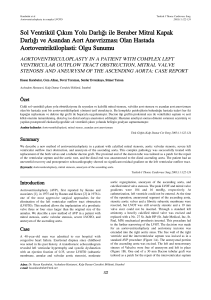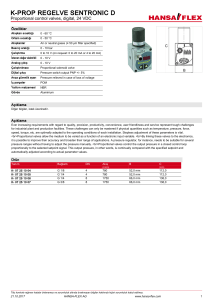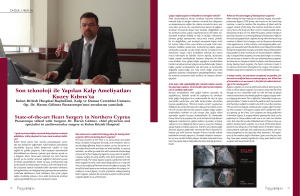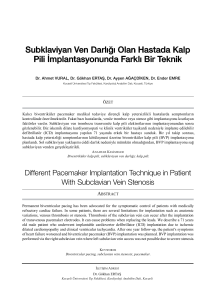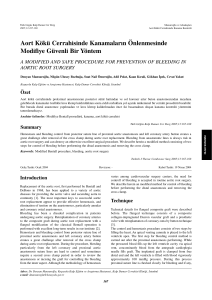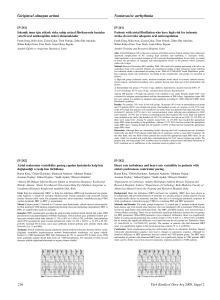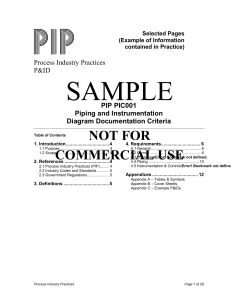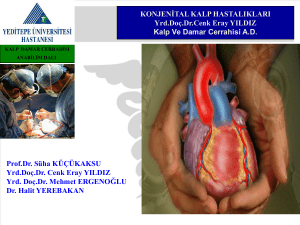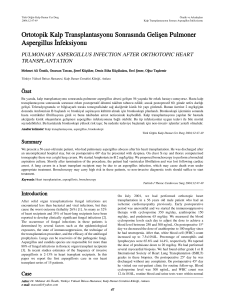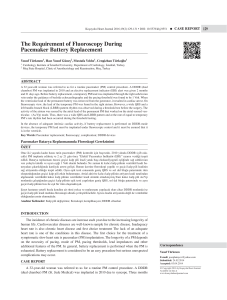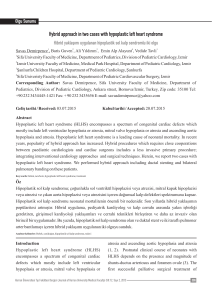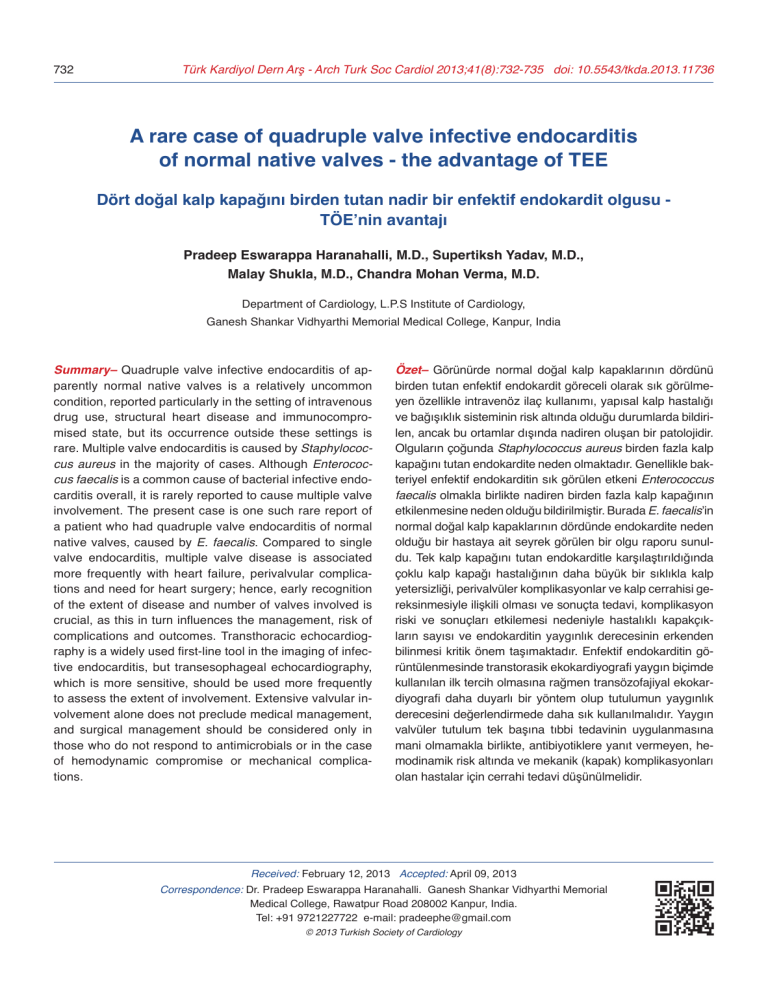
732
Türk Kardiyol Dern Arş - Arch Turk Soc Cardiol 2013;41(8):732-735 doi: 10.5543/tkda.2013.11736
A rare case of quadruple valve infective endocarditis
of normal native valves - the advantage of TEE
Dört doğal kalp kapağını birden tutan nadir bir enfektif endokardit olgusu TÖE’nin avantajı
Pradeep Eswarappa Haranahalli, M.D., Supertiksh Yadav, M.D.,
Malay Shukla, M.D., Chandra Mohan Verma, M.D.
Department of Cardiology, L.P.S Institute of Cardiology,
Ganesh Shankar Vidhyarthi Memorial Medical College, Kanpur, India
Summary– Quadruple valve infective endocarditis of apparently normal native valves is a relatively uncommon
condition, reported particularly in the setting of intravenous
drug use, structural heart disease and immunocompromised state, but its occurrence outside these settings is
rare. Multiple valve endocarditis is caused by Staphylococcus aureus in the majority of cases. Although Enterococcus faecalis is a common cause of bacterial infective endocarditis overall, it is rarely reported to cause multiple valve
involvement. The present case is one such rare report of
a patient who had quadruple valve endocarditis of normal
native valves, caused by E. faecalis. Compared to single
valve endocarditis, multiple valve disease is associated
more frequently with heart failure, perivalvular complications and need for heart surgery; hence, early recognition
of the extent of disease and number of valves involved is
crucial, as this in turn influences the management, risk of
complications and outcomes. Transthoracic echocardiography is a widely used first-line tool in the imaging of infective endocarditis, but transesophageal echocardiography,
which is more sensitive, should be used more frequently
to assess the extent of involvement. Extensive valvular involvement alone does not preclude medical management,
and surgical management should be considered only in
those who do not respond to antimicrobials or in the case
of hemodynamic compromise or mechanical complications.
Özet– Görünürde normal doğal kalp kapaklarının dördünü
birden tutan enfektif endokardit göreceli olarak sık görülmeyen özellikle intravenöz ilaç kullanımı, yapısal kalp hastalığı
ve bağışıklık sisteminin risk altında olduğu durumlarda bildirilen, ancak bu ortamlar dışında nadiren oluşan bir patolojidir.
Olguların çoğunda Staphylococcus aureus birden fazla kalp
kapağını tutan endokardite neden olmaktadır. Genellikle bakteriyel enfektif endokarditin sık görülen etkeni Enterococcus
faecalis olmakla birlikte nadiren birden fazla kalp kapağının
etkilenmesine neden olduğu bildirilmiştir. Burada E. faecalis’in
normal doğal kalp kapaklarının dördünde endokardite neden
olduğu bir hastaya ait seyrek görülen bir olgu raporu sunuldu. Tek kalp kapağını tutan endokarditle karşılaştırıldığında
çoklu kalp kapağı hastalığının daha büyük bir sıklıkla kalp
yetersizliği, perivalvüler komplikasyonlar ve kalp cerrahisi gereksinmesiyle ilişkili olması ve sonuçta tedavi, komplikasyon
riski ve sonuçları etkilemesi nedeniyle hastalıklı kapakçıkların sayısı ve endokarditin yaygınlık derecesinin erkenden
bilinmesi kritik önem taşımaktadır. Enfektif endokarditin görüntülenmesinde transtorasik ekokardiyografi yaygın biçimde
kullanılan ilk tercih olmasına rağmen transözofajiyal ekokardiyografi daha duyarlı bir yöntem olup tutulumun yaygınlık
derecesini değerlendirmede daha sık kullanılmalıdır. Yaygın
valvüler tutulum tek başına tıbbi tedavinin uygulanmasına
mani olmamakla birlikte, antibiyotiklere yanıt vermeyen, hemodinamik risk altında ve mekanik (kapak) komplikasyonları
olan hastalar için cerrahi tedavi düşünülmelidir.
Received: February 12, 2013 Accepted: April 09, 2013
Correspondence: Dr. Pradeep Eswarappa Haranahalli. Ganesh Shankar Vidhyarthi Memorial
Medical College, Rawatpur Road 208002 Kanpur, India.
Tel: +91 9721227722 e-mail: [email protected]
© 2013 Turkish Society of Cardiology
A rare case of quadruple valve infective endocarditis of normal native valves
Q
uadruple valve infective endocarditis of apparently normal native valves by itself is a relatively
uncommon condition, reported mainly in the setting
of intravenous drug use[1] and immunocompromised
state,[2] but its occurrence outside these settings is
rare. The causative microorganism reported in the
overwhelming majority of native multiple valve endocarditis cases is Staphylococcus aureus.[3,4] Although
Enterococcus faecalis is the third most common cause
of bacterial endocarditis overall, it is rarely known to
cause multiple valve endocarditis.[3]
We report the case of a patient who had quadruple
valve infective endocarditis caused by E. faecalis, on
apparently normal native valves. Although transthoracic echocardiography (TTE) is a quintessential tool
in the diagnosis of infective endocarditis, transesophageal echocardiography (TEE) increases the sensitivity.
In our case, identification of vegetations on the mitral
valve was possible
Abbreviations:
only with the help of
TEE Transesophageal echocardiography
TEE, thus emphasizTTE Transthoracic echocardiography
ing the role of TEE in
733
studying the extent of disease. Early recognition of the
extent and number of valves involved is crucial, as this
in turn influences the management, risk of complications and outcomes.[4]
CASE REPORT
A 16-year-old girl presented with a history of intermittent fever of six months’ duration associated
with anorexia and significant weight loss. She was
apparently healthy prior to this six- month period,
with an unremarkable medical history. On examination she was febrile (39.4 °C), with a pulse rate of
115 beats per minute regular and blood pressure of
118/60 mmHg. Jugular venous pulse was normal in
height with prominent ‘v’ wave. On cardiovascular
examination, there was grade II/III early diastolic
murmur at the base and grade III/VI pansystolic murmur at the lower left parasternal area. Respiratory,
abdominal and nervous system examinations were
unremarkable. On admission, her blood test reports
were as follows: hemoglobin, 9.8 g/dl; total leukocyte count, 18.2×109/L; neutrophils, 15.5×109/L;
A
B
C
D
E
F
Figure 1. (A) Transthoracic echocardiography parasternal long-axis view showing vegetation over the aortic valve (arrow). The
mitral valve is apparently not involved (See movie clip MC1). (B) Parasternal short-axis view at the aortic valve level showing
vegetations over the pulmonary valve (arrow) and aortic and tricuspid valves (See movie clip MC2). (C) Apical four-chamber
view showing vegetations on tricuspid and aortic valves and mural endocardium of the RV (arrow). (D) Color Doppler in parasternal short-axis view showing pulmonary regurgitation (arrow) (See movie clip MC3). (E) Color Doppler in parasternal long-axis
view showing moderate aortic insufficiency (arrow). (F) Color Doppler in apical four-chamber view showing moderate tricuspid
regurgitation (arrow). Ao: Aorta; LA: Left atrium; LV: Left ventricle; PA: Pulmonary artery; RV: Right ventricle.
Türk Kardiyol Dern Arş
734
A
B
C
D
Figure 2. (A) Transesophageal echocardiography, left ventricular long-axis view (135°) showing vegetations over ventricular surface of the aortic valve (arrow) (See movie clip VC1). (B)
Modified LV long-axis view (87°) showing vegetations over mitral (white arrow), aortic (red arrow) and pulmonary (yellow arrow) valves (See movie clip VC1). (C) Four-chamber view (0°)
showing vegetations over tricuspid valve (upper arrow) and RV (lower arrow) (See movie clip
VC2). (D) Left ventricular long-axis view (135°) with color Doppler showing moderate aortic
regurgitation (arrow). Ao: Aorta; LA: Left atrium; LV: Left ventricle; PV: Pulmonary valve; RA:
Right atrium; RV: Right ventricle.
urea, 17.9 mmol/L; creatinine, 166 mmol/L; sodium,
137 mEq/L; potassium, 4.7 mEq/L; erythrocyte sedimentation rate (ESR), 48 mm in the first hour; and
C-reactive protein, 250 mg/L. TTE revealed vegetations on ventricular surfaces of aortic, pulmonary, and
tricuspid valves and on the mural endocardium of the
right ventricular inflow tract with an apparently unaffected mitral valve. Mild pericardial effusion was also
observed (Fig. 1a- c; see corresponding videos MC1
- MC3*). Color Doppler study revealed moderate aortic insufficiency, moderate tricuspid regurgitation and
pulmonary regurgitation (Fig. 1d-f; see corresponding
videos MC1 - MC3*). Blood cultures were taken, and
she was started on empiric antimicrobials with intravenous benzyl penicillin and gentamicin at appropriate doses. TEE was performed to further delineate
the extent of disease. It confirmed the TTE findings
(Fig. 2a-d; see corresponding videos VC1 and VC2*),
and in addition, revealed vegetations on the ventricular surface of the anterior mitral leaflet (Fig. 2b; see
corresponding video VC1*). Three out of four blood
cultures reported growth of E. faecalis, which was
sensitive to imipenem and linezolid. Empiric antimi-
crobials were switched to imipenem with linezolid at
appropriate doses and were continued for six weeks.
She responded to the treatment and remained afebrile
from the fourth day onwards. As she remained afebrile, without any hemodynamic compromise, she
was managed conservatively and then discharged. On
evaluation during follow-up visits at one month and
four months of discharge, she was asymptomatic.
DISCUSSION
Most cases of echocardiographically demonstrated
infective endocarditis are single valve diseases; the
involvement of two valves occurs less frequently, and
triple or quadruple valve involvement occurs even
less frequently.[5] Some series have reported E. faecalis as the causative organism in multiple valve endocarditis, particularly in the postoperative period,[5,6]
but to our knowledge, such extensive involvement by
E. faecalis in normal native valves has not been reported. Compared to single valve endocarditis, multiple valve disease is more frequently associated with
heart failure, perivalvular complications and need for
A rare case of quadruple valve infective endocarditis of normal native valves
heart surgery. Despite this, in-hospital mortality rates
in single valve endocarditis and multiple valve disease are similar.[4] Even though obvious vegetations
are easily demonstrated on TTE, a more sensitive tool
like TEE should be used more frequently in patients
with infective endocarditis to define the extent of involvement. Our report also emphasizes that multiple
valve involvement alone does not imply the need for
surgical management; response to medical management and hemodynamic status are still the factors
guiding therapy.
Conflict-of-interest issues regarding the authorship or
article: None declared.
*Supplementary video file associated with this article
can be found in the online version of the journal.
REFERENCES
1. Piran S, Rampersad P, Kagal D, Errett L, Leong-Poi H. Extensive fulminant multivalvular infective endocarditis. JACC
Cardiovasc Imaging 2009;2:787-9. CrossRef
2. Groesdonk HV, Seeburger J, Krohmer E, Anwar N, Doll N,
3.
4.
5.
6.
735
Fassl J, et al. 4 valve endocarditis confirmed by intraoperative
transesophageal echocardiography leads to successful quadruple valve replacement. Applied Cardiopulmonary Pathophysiology 2009;13:134-7.
Krake PR, Zaman F, Tandon N. Native quadruple-valve endocarditis caused by Enterococcus faecalis. Tex Heart Inst J
2004;31:90-2.
López J, Revilla A, Vilacosta I, Sevilla T, García H, Gómez
I, et al. Multiple-valve infective endocarditis: clinical, microbiologic, echocardiographic, and prognostic profile. Medicine
(Baltimore) 2011;90:231-6. CrossRef
Kim N, Lazar JM, Cunha BA, Liao W, Minnaganti V. Multivalvular endocarditis. Clin Microbiol Infect 2000;6:207-12.
Hricak V Jr, Kovacik J, Marx P, Fischer V, Krcmery V Jr. Endocarditis due to enterococcus faecalis: risk factors and outcome in twenty-one cases from a five year national survey.
Scand J Infect Dis 1998;30:540-1. CrossRef
Key words: Echocardiography, transesophageal; endocarditis, bacterial; Enterococcus faecalis/isolation & purification; heart valve diseases/etiology/microbiology; heart valves.
Anahtar sözcükler: Ekokardiyografi, transözofajiyal; endokardit,
bakteriyel; Enterococcus faecalis/izolasyon ve saflaştırma; kalp kapak hastalıkları/etiyoloji/mikrobiyoloji; kalp kapakları.

